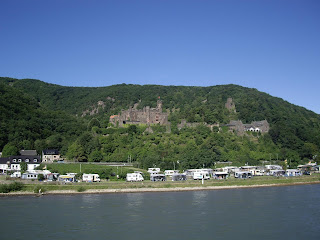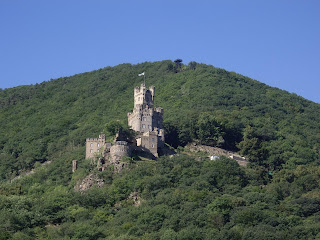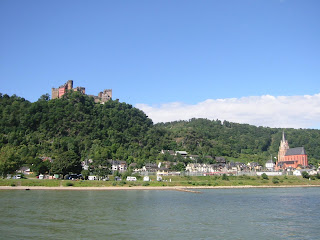Among the river cuises in Europe, Rhine River cruises are perhaps the most popular one. The first time I was in a cruise along the Rhine River was in 2002 with my friend as part of our European Tour itinerary. I was completely taken by its beauty and history. It is such a romantic place. I promised myself to see this place again. Never did I expect that I would be back not only with my husband but with my parents too.
There are approximately 40 castles and fortresses stretched along a mere 65 kilometres of the River Rhine between the cities of Bingen and Koblenz. This area is one of the most popular and most visited tourist sites in Germany. Some Rhine River cruises are sailing strictly along Rhine River in Germany and some are combined with other river cruises going to Austria, Switzerland, Netherlands, or Hungary. Rhine River cruise in Germany is serviced by a number of cruiselines; among them are the following:
KD (Köln-Düsseldorfer Rheinschiffahrt) http://www.k-d.com/englisch/index.html
Bingen-Rüdesheimer http://www.bingen-ruedesheimer.com/rhine-cruise/index.html
Their respective sailing schedules are available online, as well as the fares.
Since we were most interested to see the castles, villages and vineyards, we intended to take a cruise from Mainz to Koblenz. However, the connection of the trips was not convenient for us. So, we decided to start at Bingen up to St. Goar and St. Goarshausen. We bought our tickets at Bingen Station for the first trip at 9:30am. We were so lucky to have a fantastic weather though it was a little bit cool in the morning. I was so excited to show my parents this amazingly beautiful and romantic place.
We sailed on time and it was not too crowded. We stayed on the sundeck during the entire trip. Here are the snapshots of the breath-taking view of the Rhine River.
.JPG) In Bingen, anxiously waiting for the boat.
In Bingen, anxiously waiting for the boat.
.JPG) Behind me is the Ehrenfels Castle
Behind me is the Ehrenfels Castle
.JPG) Far behind is a vineyard and a monument 'Niederwald Denkmal´
Far behind is a vineyard and a monument 'Niederwald Denkmal´
.JPG) The town of Bingen, view from the river. In the middle is the Klopp Castle. This was mentioned in 1105, the castle served as the residence for the men of the archbishop of Mainz and, from 15th century, for a Mainz canon who was in charge of the administration of the Cathedral chapter. Today, the courtyard of the castle is open to the public.
The town of Bingen, view from the river. In the middle is the Klopp Castle. This was mentioned in 1105, the castle served as the residence for the men of the archbishop of Mainz and, from 15th century, for a Mainz canon who was in charge of the administration of the Cathedral chapter. Today, the courtyard of the castle is open to the public.
.JPG) The ruins of the Ehrenfels Castle. It was built for the Archbishop of Mainz around 1210 to protect the Rheingau in the Electorate of Mainz against attacks from the north. It served as a toll post from the beginning of the 14th century. From the middle of the 14th century, it became an arch-episcopal residence and after 1379 it came into the possession of the Mainz Cathedral chapter. Its picturesque location, set amidst vineyards, made Ehrenfels one of the most celebrated motifs of Rhine Romanticism.
The ruins of the Ehrenfels Castle. It was built for the Archbishop of Mainz around 1210 to protect the Rheingau in the Electorate of Mainz against attacks from the north. It served as a toll post from the beginning of the 14th century. From the middle of the 14th century, it became an arch-episcopal residence and after 1379 it came into the possession of the Mainz Cathedral chapter. Its picturesque location, set amidst vineyards, made Ehrenfels one of the most celebrated motifs of Rhine Romanticism.
.JPG) The Mäuseturm (Mice Tower) was built as a watchtower in the first half of the 14th century to protect Ehrenfels Castle, which collected toll duties for the Electorate of Mainz (on the right bank of the Rhine). There are many legends about the meaning of the word Mäuseturm. First recorded in 1516, it is derived from the Middle High German word ‘mûsen’, meaning to look out, to keep watch. Today this is closed to the public.
The Mäuseturm (Mice Tower) was built as a watchtower in the first half of the 14th century to protect Ehrenfels Castle, which collected toll duties for the Electorate of Mainz (on the right bank of the Rhine). There are many legends about the meaning of the word Mäuseturm. First recorded in 1516, it is derived from the Middle High German word ‘mûsen’, meaning to look out, to keep watch. Today this is closed to the public.
.JPG) The picturesque town of Assmanshausen is famous for Red Assmanshauser wine. The redwine tradition goes back to its foundation in the year 1108.
The picturesque town of Assmanshausen is famous for Red Assmanshauser wine. The redwine tradition goes back to its foundation in the year 1108.

 The Reinstein Castle's original residential tower, dating back to the 13th or 14th century, was characterised by a u-shaped ring wall which opened onto the Rhine. To the south and west, a moat and a strong curtain wall protected the approach from the mountain slope. A high wall connected the residential tower to a watchtower above the valley. This pretty castle is located at the town of Trechtingshausen and is now pivately owned.
The Reinstein Castle's original residential tower, dating back to the 13th or 14th century, was characterised by a u-shaped ring wall which opened onto the Rhine. To the south and west, a moat and a strong curtain wall protected the approach from the mountain slope. A high wall connected the residential tower to a watchtower above the valley. This pretty castle is located at the town of Trechtingshausen and is now pivately owned.

Reichenstein is one of the oldest castles on the Middle Rhine and was probably built in the early 11th century at the behest of the Kornelimünster arch abbey near Aachen. Also located in the town of Trechtingshausen. Today’s Reichenstein Castle is a typical example for an expanded castle inspired by Rhine Romanticism. The residential rooms on the upper floor house antique furniture as well as an extensive collection of historic weapons and armour. The chapel, in the New Gothic style, contains an altarpiece from 1556 as well as other works of art dating back to the 15th through 18th centuries.


 The Sooneck Castle is in the town of Niederheimbach. Although only sparsely furnished during the 19th century, the castle today houses a fine collection of Empire and Biedermeier furniture from the castles of Stolzenfels and Coblence.
The Sooneck Castle is in the town of Niederheimbach. Although only sparsely furnished during the 19th century, the castle today houses a fine collection of Empire and Biedermeier furniture from the castles of Stolzenfels and Coblence.
 The Heimburg Castle was built between 1290 and 1305 by the archbishopric of Mainz. Also located in Niederheimbach. Today this is privately owned and is not open to the public.
The Heimburg Castle was built between 1290 and 1305 by the archbishopric of Mainz. Also located in Niederheimbach. Today this is privately owned and is not open to the public.

 The ruins of the Fürstenberg Castle. The castle is built on a slope amidst vineyards overlooking the Rhine, the castle is dominated by the towering 25 metre circular keep which characteristically narrows into a battlemented crown. Today it is an open ruin and is privately owned situated above Rheindiebach.
The ruins of the Fürstenberg Castle. The castle is built on a slope amidst vineyards overlooking the Rhine, the castle is dominated by the towering 25 metre circular keep which characteristically narrows into a battlemented crown. Today it is an open ruin and is privately owned situated above Rheindiebach.
 Stahleck Castle was built in the 12th century by order of the archbishop of Cologne to protect the four-valley region around Bacharach. For centuries, the castle was owned by the most important families of the empire and proved to be quite profitable after the introduction of the Bacharach Rhine toll in the 13th century. It is located above the town of Bacharach. The courtyard can be visited.
Stahleck Castle was built in the 12th century by order of the archbishop of Cologne to protect the four-valley region around Bacharach. For centuries, the castle was owned by the most important families of the empire and proved to be quite profitable after the introduction of the Bacharach Rhine toll in the 13th century. It is located above the town of Bacharach. The courtyard can be visited.
 The Pfalzgrafenstein Castle in the island Kaub. This toll castle was built in 1326/27 because of the dispute over the Rhine toll between the Pope and King Ludwig of Bavaria. The King, who belonged to the Wittelsbach family of Counts Palatine, had made some dangerous enemies by raising the toll in Kaub. Three times, Pope John XXII called upon the archbishops of Cologne, Treves, and Mainz to excommunicate Ludwig and take action against the Kaub toll, but his calls were ignored.
The Pfalzgrafenstein Castle in the island Kaub. This toll castle was built in 1326/27 because of the dispute over the Rhine toll between the Pope and King Ludwig of Bavaria. The King, who belonged to the Wittelsbach family of Counts Palatine, had made some dangerous enemies by raising the toll in Kaub. Three times, Pope John XXII called upon the archbishops of Cologne, Treves, and Mainz to excommunicate Ludwig and take action against the Kaub toll, but his calls were ignored.
 The Gutenfels castle is also known as the cube castle built in the year 1220. It is a well-preserved example of the Staufen construction style. The ground plan, including the great hall, the courtyard, and the armoury with its two floors, is square-shaped and divided into sections of almost identical size. The great hall has a splendid southern window front and is considered one of the most beautiful and well-preserved secular buildings of the Staufen period. The flat-roofed halls still contain 13th-century fireplaces. Today it is privately owned and can only be viewed from the outside.
The Gutenfels castle is also known as the cube castle built in the year 1220. It is a well-preserved example of the Staufen construction style. The ground plan, including the great hall, the courtyard, and the armoury with its two floors, is square-shaped and divided into sections of almost identical size. The great hall has a splendid southern window front and is considered one of the most beautiful and well-preserved secular buildings of the Staufen period. The flat-roofed halls still contain 13th-century fireplaces. Today it is privately owned and can only be viewed from the outside.


The Schönburg Castle near the town of Oberwesel was built during the first half of the 12th century. It was owned by the bishop of Magdeburg and was passed into the possession of the Emperor Friedrich I in 1166. The castle consists of three courtyards arranged at different heights. The central courtyard is the oldest part of the castle and originally had a ditch on its southern side. The square-shaped gate tower also seems to have been built at that time. In the 13th century, up to eight branches of the family were living on the castle grounds. The southern upper courtyard with its two adjacent circular towers, the great hall, and the Gothic chapel as well as the bowers, a rectangular residential gate building of three storeys, are believed to date from this time.

The Katz Castle was constructed around 1360 by Count Wilhelm II von Katzenelnbogen that would later bear the name of its founder. Built halfway up the hill, Katz Castle’s original function was to protect St. Goarshausen, which belonged to the Katzenelnbogen family. In the 17th and 18th centuries, though, it also served as an outpost for the Rheinfels fortress on the opposite side, thus ensuring with its garrison that Rheinfels could ward off the French siege in the Palatinate War of Succession in 1689. It is situated above the town of St. Goarshausen. Today it is privately owned and is not open to visitors.
 The Rheinfels Fortress today is one of the largest ruins on the River Rhine. In 1245, Count Diether von Katzenelnbogen gave orders for the hilltop castle near St. Goar to be built. Its lively court life made the toll castle a cultural centre on the Middle Rhine in the 14th and 15th centuries. In 1479, it passed into the possession of the Hessian landgraves.
The Rheinfels Fortress today is one of the largest ruins on the River Rhine. In 1245, Count Diether von Katzenelnbogen gave orders for the hilltop castle near St. Goar to be built. Its lively court life made the toll castle a cultural centre on the Middle Rhine in the 14th and 15th centuries. In 1479, it passed into the possession of the Hessian landgraves.
.JPG) Far behind us is the Rheinfels Fortress. It is open for visitors. To go up to the castle, a train express is available for a few euros fee. It is about 17 km ayaw from the downtown.
Far behind us is the Rheinfels Fortress. It is open for visitors. To go up to the castle, a train express is available for a few euros fee. It is about 17 km ayaw from the downtown.

 The world famous Rock of Loreley. The legend says that Loreley is a beautiful young maiden who committed suicide because of an unfaithful lover. She jumped from the steep rock into the Rhine River, thus killing herself. She then became a siren, luring shipmen to their fates with her hypnotizing voice. The echoing heard today is said to be Loreley. A monument above the rock is frequented by visitors.
The world famous Rock of Loreley. The legend says that Loreley is a beautiful young maiden who committed suicide because of an unfaithful lover. She jumped from the steep rock into the Rhine River, thus killing herself. She then became a siren, luring shipmen to their fates with her hypnotizing voice. The echoing heard today is said to be Loreley. A monument above the rock is frequented by visitors.
The Loreley is a rock on the eastern bank of the Rhine near St. Goarshausen, Germany, which soars some 120 meters above the water line. It marks the narrowest part of the river between Switzerland and the North Sea. A very strong current and rocks below the waterline have caused many boat accidents there.
.JPG) One of the luxury cruises passing by.
One of the luxury cruises passing by.
For more information about Rhine Rivers Castles and Fortresses, visit this website http://www.welterbe-mittelrheintal.de/index.php?id=35&L=3
Some photo captions are excerpts of the above source.
We got off at the town of St. Goar and went around for sight-seeing. The town is compact but it depicts a very strong character and history. After our coffee break, we visited the Catholic Cathedral, scanned though souvenir shops, went around town, relaxed at the park by the river and treated ourselves to an Asian lunch in a historical wine cellar.
.JPG)
.JPG)
.JPG)
.JPG) The Souvenir shop
The Souvenir shop
.JPG)
.JPG) The Coocoo clocks
The Coocoo clocks
.JPG) Wine tasting
Wine tasting
.JPG) coffee time
coffee time
.JPG) The Express train to the Castle
The Express train to the Castle
.JPG)
.JPG) The Asian Restaurant... a very old wine cellar
The Asian Restaurant... a very old wine cellar
.JPG) The biggest hanging coocoo clock in the world
The biggest hanging coocoo clock in the world
.JPG) Cruising back to Bingen, we're at the restaurant deck.
Cruising back to Bingen, we're at the restaurant deck.
.JPG) A the town of Bingen
A the town of Bingen
.JPG) Overall, it was a fantastic day trip.
Overall, it was a fantastic day trip.
To view the complete photo album, click
http://jernie1.myphotoalbum.com/view_photo.php?set_albumName=album06&id=cruiserhine_02
.JPG)
.JPG)
.JPG)
.JPG)
.JPG)
.JPG)
.JPG)












.JPG) Far behind us is the Rheinfels Fortress. It is open for visitors. To go up to the castle, a train express is available for a few euros fee. It is about 17 km ayaw from the downtown.
Far behind us is the Rheinfels Fortress. It is open for visitors. To go up to the castle, a train express is available for a few euros fee. It is about 17 km ayaw from the downtown.
.JPG)
.JPG)
.JPG)
.JPG)
.JPG)
.JPG)
.JPG)
.JPG)
.JPG)
.JPG)
.JPG)





.JPG)
.JPG)
.JPG)
.JPG)
.JPG)